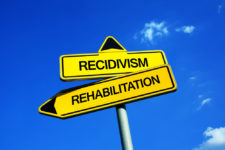Punishment vs Rehabilitation in the Criminal Justice System

John has had a busy week fishing, looking after horses, and pruning his fresh crop of vegetables, so he’s quite pleased to retire to his room alone, and watch some television before bed.
Without context you’d assume John was an ordinary citizen. But in fact, he is an inmate at the Bastoy gaol in Norway – the “world’s nicest prison”, as it’s commonly referred to.
Prison life in the Nordic region is a marked contrast from that of countries like the USA and Australia, where a “tough on crime” mantra prevails.
Bastoy inmates are given private rooms and a weekly allowance of around $90 which they can use to buy their own groceries from the supermarket.
Though controversial, the rates of reoffending in Nordic nations are far lower than those of their punitive counterparts.
According to ABS statistics 221 per 100,000 people in Australia are behind bars on any given day and 45.6% of these will return to prison within two years of release. This compares with just 75 people per 100,000 in Norway and a recidivism rate of just 20%.
These statistics do beg the question, why don’t other countries follow suit?
Indeed, Australia has gradually take steps towards a more rehabilitative model of criminal justice over time.
Historical shift
Over the generations, Australia abandoned the staunchly punitive model of our Colonial period.
Back in our early days, around 300 crimes were punishable by death; many relating to theft from a property such as stealing a sheep, and also fraud offences such as forgery.
When a person was executed – traditionally by hanging – it was common for large crowds of the general public to attend, even bring their children to watch.
However, many were spared the death penalty due to the prerogative of mercy, in which a Governor and Executive Council would take into account mitigating factors and pardon the prisoner.
For those pardoned, prison life wasn’t much of a consolation, however. Prisoners were routinely abused, tortured or treated like animals.
Death of the death sentence
In 1973, Australia abolished capital punishment with the Death Penalty Abolition Act 1973, but it did not roll out fully throughout the country until 1985, with New South Wales being the last state to adopt.
It was a major milestone in Australia’s journey towards a more rehabilitative model of criminal justice. However, the effects of punishment on human behaviour were still not well known at this time – and to satisfy community expectations, the prison system was still highly punitive for the years that followed.
Prison environments were harsh and overcrowded, with few pre- and post-release intervention strategies in place.
Positive intervention
By the turn of the millennium, rehabilitative models were beginning to gain traction, mostly due to a major incarceration boom, which had left governments with little choice but to explore new models of criminal justice.
These innovative models recognised the potential to positively intervene in the lives of offenders, address their criminogenic needs, and restore them to high functioning member of society.
These initiatives were supported by a growing body of evidence showing that rehabilitation is generally far more successful at reducing recidivism than punishment; and that incarceration by itself may actually increase reoffending.
Rehabilitation frameworks saw an increase in onsite mental health support, a focus on prison architecture and design – to improve layout, aesthetics and acoustics – and a variety of new programs to support prisoner wellbeing.
A Nordic approach
In the last decade, Australia’s rehabilitative framework has been picking up pace and has been more closely emulating Norway’s approach.
In 2018, Australia ratified the Optional Protocol to the Convention Against Torture (OPCAT) in a bid to stomp out cruelty and mistreatment towards prisoners.
The Alexander Maconochie Centre, which opened in 2008, houses around half of its inmate in shared cottages and promotes skill development, through a range of programs.
In addition, privately-run Ravenhall prison offers pre- and post-release intervention, as well as extensive onsite mental health support.
Some governments have also incentivised private operators to reduce the rates of recidivism. GEO for example was promised a $2 million bonus if it was able to slash rates by 12 percent, relative to the rest of the prison system.
With these “pay for success” models in place and becoming more popular, private operators are having no choice but to lean towards models which actually work: i.e. rehabilitation models.
To this end, their focus has been on softening prison design, reducing overcrowding and providing facilities for self-improvement, such as libraries and mental health facilities.
Though Australian prison beds aren’t quite akin to hotel beds – as befits the Norwegian system – they do seem to be striking a delicate balance between society’s expectations and the recidivism literature, for the time being.
Evolution and positive change is occurring, just not perhaps at the same rate as some of our global peers.






